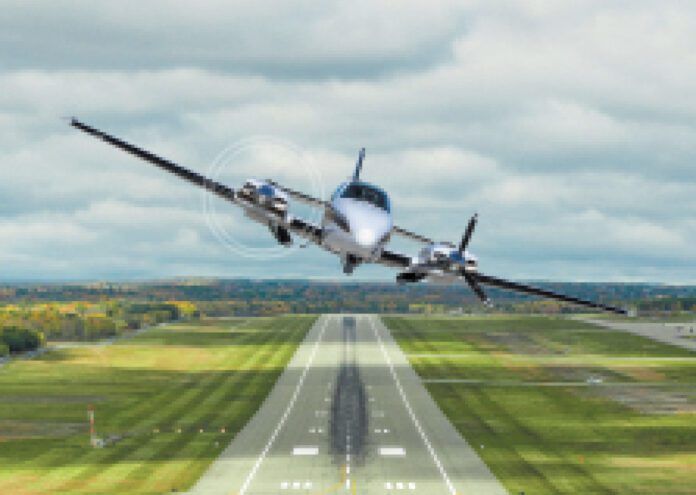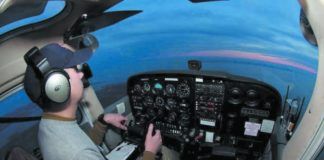Often I’ve railed against the inability of approved aviation training devices (sims) to mimic the aircraft we fly. If your panel has had any upgrades, you’ll generally not find a sim that comes close. This limits the value of sim training in maintaining proficiency for your aircraft.
So, why not train in your airplane? Training for complex aircraft is inferior in the airplane. In the sim you can trigger countless failures, an engine-driven fuel pump for example, that just can’t be created in the air. So, your instructor simply covers an instrument, or announces, “Oil pressure failure on the left engine.” In reality, those are often slow, subtle failures that can go unnoticed. If the instructor announces it, much of the training value is lost.
Beyond failures you can’t create in the airplane, some failures you avoid in the airplane for safety reasons. If a pilot detects the declining oil pressure before the engine quits, the usual way of handling it is to do a precautionary engine shutdown. (Assume a twin.) Engine-out maneuvering, approaches, and landings are a staple of multi-engine training, but they’re also high-risk—if anything goes wrong, either more failures of any kind or pilot deficiency handling the airplane, some seriously bad things can happen quickly. So, most instructors who offer engine-out training in the air at all, typically do so only at higher altitudes.
Failures that affect an airplane’s ability to stay in the air are conceptually far different when done at altitude from those same failures down low where you’re struggling to avoid terrain and obstacles. So, safely practicing failures of this type in the airplane is often lacking in realism and thus training value. We’re back to the sim where far more failures can be triggered and all can be conducted safely.
In complaining that we can’t replicate most of our panels in certified sims, I’ve offered the compromise of recurrent training in a sim followed up with some hood work in your airplane. Still, that’s a compromise—the ideal solution is to do it all in a sim that closely replicates the aircraft you fly.
Actually, with some (not insignificant) limitations surrounding the latest avionics, you can usually come rather close with available sim components if you build it. (See our series on DIY sims.) But, while the resulting sim can come closer to your aircraft, it won’t be certified and you can’t log the time. Some argue that logging is just a bonus, but the general feeling is that logging your sim training is a requirement.
Why can’t we have certified, custom-built sims? Blame the FAA. Real approved aircraft components are given a TSO or an STC allowing you to install a specific radio, for example, in any aircraft. ATD sims, however, are certified as a whole. So, if you want to put a GTN navigator into a sim that was certified with GNS navigators, you’ve got to start the lengthy certification process from scratch. That’s beyond practical, so we end up with certified sims that are so basic that they’re unrealistic.
Unless that changes, the best I can recommend is recurrent training in a sim focusing on failures, coupled with avionics practice and approaches in your actual airplane.






Disagree. Sim training has its advantages but ultimately there is no substitute for flying the actual plane and a sim will never be able to replicate the realism of actually flying.
I’ve found a balance of practice on a personal pc which very closely replicates the SEL HP/Comp I fly to practice buttonology (GTN650) at near zero cost and with situations unthinkable in a real airplane. Time in an FAA approved training sim to meet the legal requirements which actually has lesser value than my pc sim. And lastly, time in the actual aircraft.
I’ve been a full motion, AATD, and PC multi sim instructor 36 years. I have trained pilots in light, medium piston, turboprop and turbine aircraft, as well as Boeing transports. I also train pilots using X-Plane 11&12. I do not advocate multi training in actual aircraft except basic maneuvers and IFR procedures. Simulator training, no matter what type or level, is far superior to actual aircraft training at every level. I have yet to find much value in non simulator training for normal or abnormal procedures in multi-engine aircraft. I have had dozens of pilots tell me that it was the training they recieved in a simulator that saved their life. With virtual reality now becoming ever more present in simulation, the value of such training is incalculable. The ability to train at any airport in the world, in any weather condition and every concievable system or engine failure is something no actual aircraft can accomplish. Take a look at X-Plane 12, the capabilities are stunning and on par with Level D simulators l have conducted training in. The F-4 is so accurate the IAF uses it for their pilots. I don’t find motion all that useful in simulators, they only have 3° of pitch and roll and 6″ of lateral/hoizontal movement and 24″ of verticle. Most of the motion is used for takeoff and landing and light turbulence, otherwise the sim is stationary. Most pilots don’t realize when the motion is turned off as the eyes do an exceptional job at decieving the senses. Under VR the sense of movement is stunning. I have on very few motion based sims had pilots get vertigo or other flight illusions. In VR this is quite common, and produces realistic illusions. After 2 hours using VR pilots end the session believing they have been in actual flight. I will continue to use simulators for the majority of my training flights. Currently I teach at a college students who aspire to be professional pilots. They will be far better trained and have much more valuable training than I did when I started flying in 1975 because of simulators.
I train in my own Super Seawind by plugging in a GPU and reviewing the many normal and emergency functions of the G900X, the experimental version of the G1000. I also train with emergency procedures by simulating actions and sequences I would take when they occur. Additionally, I train with the Grand Rapids Technology, GRT, HX for such things as synthetic vision and VNAV approaches (simulated). This training is 100% specific to my airplane – far better than any Sim where I have got FAA credit on. My Q: Since my airplane is FAA certified Airworthy, does any of this training with or without a qualified instructor count for proficiency?
Steve: Sim training in a non FAA certified sim, proficiency, yes. CURRENCY, no.
In your airplane, everything counts for proficiency.
For CURRENCY, takeoffs and landings count, holds and approaches in actual count, holds and approaches under the hood with a safety pilot, whether or not he/she is an instructor, count.